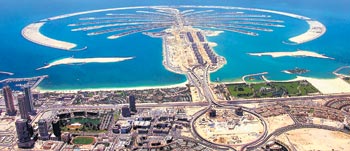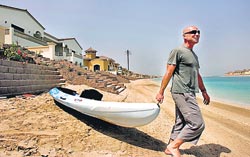
Mansions in the seaFirst residents of Dubai's palm-shaped manmade island like their pricey digs DUBAI, United Arab Emirates (AP) - Four years ago there was nothing here but unbroken sea. Now there's Andrew Dukes and his luxury mansion - sitting on a palm-shaped, manmade island - the first of about 100 houses to open here."I got exactly what I paid for and I'm very happy with it," said Dukes, 43, a tanned Englishman who just moved into his colossal home on Palm Jumeirah, Dubai's greatest-yet construction project. When finished, Palm Jumeirah will number about 120,000 residents and workers spending their days on an island made of rock blasted from nearby mountains and sand dredged from the bottom of the Persian Gulf.
Each of the 100 mansions sits on a kilometre (half-mile) long palm frond, packed in among dozens or sometimes hundreds of others. Sharing close quarters with his neighbours doesn't bother Dukes, formerly an executive with a London-based Internet company. "Living in London you're absolutely on top of each other. So if you're English-European coming here, you think the plot size is more than adequate," he said. Dukes paid around US$1.36 million (euro1 million) for his house just over a year ago. It is now worth almost twice that. He spends his days discovering uses for the large expanse of water that starts a few metres from his back door. "I've been kayaking ... and I'm going to do windsurfing next," he said. The first of Dubai's many ongoing mega-projects has literally changed the shape of the United Arab Emirates, re-contouring its coast with a new island mass that has altered sea currents and marred the once unbroken sea view from Dubai's natural beach. The entire coastal development, led by Dubai government-owned Nakheel, includes three massive palm-shaped islands along with a cluster of 300 islets built in the shape of a world map. All are built mostly of bright sand dredged up from the seabed.
The largest of Dubai's ongoing reclamation projects, the Palm Deira, is still being raised from the sea floor. Nakheel claims that the Palm Deira will be the world's largest reclaimed island, with more than one million people eventually living or working there. But that figure is called into question by frequent alterations in the island's design over the past two years. Another island, the Palm Jebel Ali, is 90 percent reclaimed but building has yet to start on its homes, resorts and hotels. Only the smallest of the palm islands, Jumeirah, has begun to be populated. Still under construction are the Palm Jumeirah's 32 hotels, monorail, water theme park, and the Trump International Hotel and residence tower. The developments are central to Dubai's property boom. Properties on the Palm Jumeirah, the first to be opened, have skyrocketed in value after being sold and resold before even being built. But the smaller islands of the third project - The World - haven't fared so well. Three years after their sales launch, just 45 percent of the islets have been sold, for prices ranging between US$10 million (euro7.4 million) and US$45 million (euro33.3 million), Nakheel said. The luxurious islands are part of a government plan to attract tourists and lure foreign cash into the tax-free economy. Dubai's government has identified tourism and real estate developments as key sectors to break the emirate's dependence on high oil prices to buttress its economy. Other nations in the region, including Qatar and Oman, as well as the Emirates capital Abu Dhabi, are quickly borrowing from Dubai's model to develop similar, albeit less dramatic, plans. The construction of the Palm Jumeirah has already created a national asset worth as much as US$23 billion (euro17 billion), said Nakheel chief executive Chris O'Donnell. Despite its opulence and ambitions, few global celebrities have been lured to buy second homes in Dubai. British soccer stars, including David Beckham, have bought properties on the Palm Jumeirah, according to Nakheel's Web site. Others are said to have taken a look. Nakheel's Web site claims pop star Michael Jackson, supermodel Naomi Campbell and actor Denzel Washington have shown interest. The developers say the first 4,000 condos and homes sold on Palm Jumeirah went to citizens of the United Arab Emirates and other Persian Gulf countries. Britons accounted for about 25 percent of the buyers with the rest from 75 different nationalities, including several Americans. Buyers are a mix of speculators, long-term residents and people wanting a vacation home, developers said. Not all the residents of the Palm Jumeirah are mega-rich. One section serves as a labour camp for the thousands of construction workers who toil in the baking sun. They will gradually be moved out as the project nears completion in the next three to four years. The project has not been without problems. A full year's delay was caused by settling of the island's new land. Nakheel solved the problem by adding more sand and hiring a Dutch firm to compact it with vibrating machines. In June, a large fire broke out in a half-built apartment building, injuring three workers. Some residents have complained about delays in getting their houses. Others complain that Nakheel is squeezing extra profits out of the island by packing in far more houses than their sales brochures showed. A broad highway bridge links Palm Jumeirah to the mainland's road network. The monorail with four stops is due to be completed next year, according to Nakheel. Plans call for five clubhouses, each with gyms, restaurants and shopping on the island. The main shopping center will be built at the tip of the trunk, where the Trump hotel will be located. Nakheel puts the delays down to the massive engineering tasks they face in building an island like none before it."With Palm Jumeirah, which is unique in its nature, there are developments along the way, like the decision to vibro-compact the sand," O'Donnell said. "Most customers are understanding of the delays." Aggravation has been tempered by the massive increase in house prices since the properties hit the market. Many houses have tripled in value, at least. And as long as property values continue to rise, owners seem willing to put up with the inconveniences. "I paid about 2.8 million dirhams (US$760,000;euro560,000) three years ago, it's worth about 9 million dirhams (US$2.5 million; euro1.8 million) now," said Dr. Ossama al-Babbili, a Dubai-based pathologist. "Every day I'm getting one or two offers, but I like to live here, it's beautiful." O'Donnell points to the price increase as a sign of the venture's success."This is something people said couldn't be done," he said. "Well it's been done." |
|| Front
Page | News | Editorial | Columns | Sports | Plus | Financial
Times | International | Mirror | TV
Times | Funday
Times || |
| |
Copyright
2007 Wijeya
Newspapers Ltd.Colombo. Sri Lanka. |

